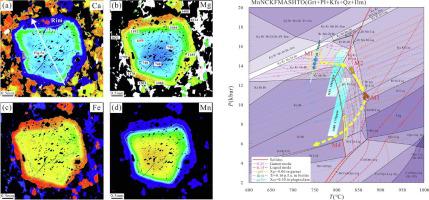Gondwana Research ( IF 7.2 ) Pub Date : 2021-07-14 , DOI: 10.1016/j.gr.2021.07.006 Qingyun Li 1 , Lifei Zhang 1 , Xu Chu 2 , Guibin Zhang 1 , Thomas Bader 1 , Yang Wang 1 , Chenguang Wu 1

|
HP pelitic granulites associated with eclogites from the Kharta Gneiss are found in the Thongmön area, central Himalaya, which provides significant constraints for the tectonic evolution of the Himalayan orogeny. Three generations of garnets are identified in pelitic granulites (DR15P15). The first generation of garnet is core sections of euhedral to subhedral porphyroblasts (Grt-I core) followed by growth of Grt-I mantle during the heating stage. The third generation of garnet is represented by thin rims of Grt-I and small grains (Grt-II) in the matrix, which likely nucleated and grew in response to peritectic reaction during exhumation. Petrographic evidence and P–T pseudosection calculation reveal a four-stages metamorphic evolution: 1) a prograde metamorphic stage (M1) represented by Grt-I core and its mineral inclusions rutile, ilmenite and quartz with metamorphic conditions of 740–760 °C and 13–16 kbar; 2) a near isobaric heating stage with slightly decompression to HP granulite-facies (M2, 820–840°C, 13–14 kbar) indicated by the composition of Grt-I mantle and the increase of Zr concentrations of rutile in it; 3) a heating decompression stage (M3) supported by a decrease in grossular content in the Grt-I rim and higher XAn in plagioclase, yielding T > 860°C and P = 10–11 kbar in the sillimanite stability field; 4) a final decompression stage followed by cooling (M4, T ∼ 800°C and P = 6–8 kbar) indicated by biotite replacing sillimanite and lower Ti content in biotite in the matrix. Based on the zircon trace element geochemistry, zircon inclusions, and the REE partitioning between garnet and zircon, the metamorphic zircon rims with middle Miocene age (16-13Ma) probably grew during Grt-I rim/ Grt-II formation at granulite facies stage (M3). The P–T history of the pelitic granulites of the Kharta Gneiss indicates that they were subducted beneath the Asian plate and exhumed to middle-lower crustal depths prior to 14–13Ma due to the activity of STDS.
中文翻译:

藏南喀尔达地区高压泥质质粒岩变质PT路径、锆石U-Pb定年及构造意义
在喜马拉雅中部的通蒙地区发现了与喀尔达片麻岩榴辉岩相关的 HP 泥质麻粒岩,这为喜马拉雅造山运动的构造演化提供了重要限制。在泥质麻粒岩 (DR15P15) 中鉴定出三代石榴石。第一代石榴石是自形到半自形的卟啉细胞(Grt-I 核心)的核心部分,随后在加热阶段生长 Grt-I 地幔。第三代石榴石的代表是基质中的 Grt-I 和小晶粒 (Grt-II) 的薄边缘,它们可能在剥落过程中响应包晶反应而成核和生长。岩相学证据和P-T伪剖面计算揭示了四个阶段的变质演化:1) 以 Grt-I 核心及其矿物包裹体金红石、钛铁矿和石英为代表的前进变质阶段 (M1),变质条件为 740–760 °C 和 13–16 kbar;2) 接近等压加热阶段,轻微减压到 HP 麻粒岩相(M2,820-840°C,13-14 kbar),由 Grt-I 地幔的组成和其中金红石 Zr 浓度的增加表明;3) 加热减压阶段 (M3) 由 Grt-I 边缘中的总体含量减少和更高的 X An 支持在斜长石中,在硅线石稳定性场中产生 T > 860°C 和 P = 10–11 kbar;4)最后的减压阶段,然后是冷却(M4,T ∼ 800°C 和 P = 6-8 kbar),由黑云母取代硅线石和基质中黑云母中较低的 Ti 含量表示。根据锆石微量元素地球化学、锆石包裹体和石榴石与锆石的稀土元素分配特征,中中新世(16-13Ma)变质锆石边缘可能生长于麻粒岩相阶段Grt-I边缘/Grt-II形成阶段( M3)。Kharta 片麻岩泥质麻粒岩的P-T历史表明,由于 STDS 的活动,它们在 14-13Ma 之前俯冲到亚洲板块之下并挖掘到中下地壳深度。











































 京公网安备 11010802027423号
京公网安备 11010802027423号